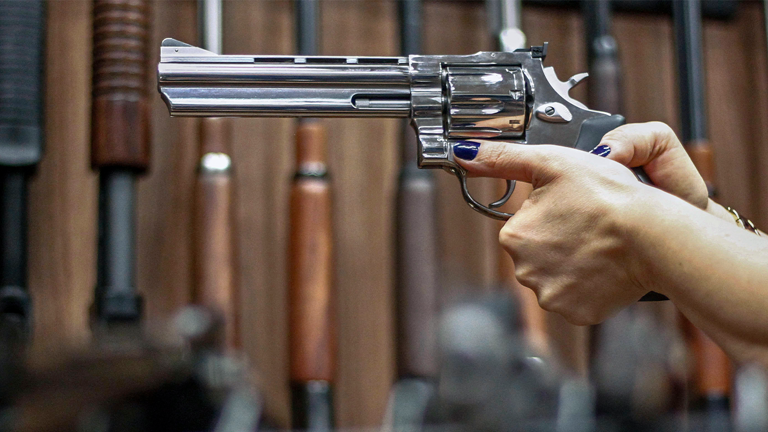Epoch Times.
ILION, N.Y.—In the village of Ilion, New York, 80 miles west of the state capital in Albany, residents are mourning the departure of gunmaker Remington Arms Co. after two centuries of continuous operation.
Without fanfare, the company announced last month that the manufacturing plant would be closing its doors on March 4, 2024.
“I feel like a family member has died,” Ilion Mayor John Stephens told The Epoch Times. “My dad raised four kids on a paycheck from there for 37 years. He walked to work and carried his lunch every day.”
Mr. Stephens said no one expected the announcement a week after Thanksgiving that the plant was set to close.
On Nov. 30, at 3:26 p.m., the company notified village officials of the decision by email. The message noted that “all separations” with the village would be completed by March 18, 2024.
Likewise, the company notified its 270 employees that they would soon be out of a job.
“They brought the second and third shifts in and said they were done,” Mr. Stephens said. “They notified the first shift in person. I found out through the media. The owner’s group didn’t even contact me.”
Mr. Stephens said the company made the announcement just five months into a newly ratified employee union contract.
“To say we were shocked [by the announcement] is probably an understatement,” the mayor told Ilion’s Village Board of Trustees at a public meeting on Dec. 11.
“In my opinion, it’s unfortunate and extremely unprofessional.”
Remington Arms didn’t return messages from The Epoch Times asking for comment.
Publicly, the company attributed the plant closure in part to a hostile political climate in Albany regarding firearms production.
“I am writing to inform you that RemArms LLC has decided to close its entire operation at 14 Hoefler Avenue, NY 13357,” Remington Arms said in a letter to employees. “The company expects that operations at the Ilion facility will conclude on or about March 4, 2024.”
The Georgia-based company said it would continue to make firearms at its facility in Huntsville, Alabama, which opened in 2014, a year after New York’s passage of the Safe Act, which created stricter gun laws.
The anti-gun political climate in Democrat-controlled Massachusetts prompted competitor Smith & Wesson to move from its longtime base in Springfield to Maryville, Tennessee. The company announced the opening of its new headquarters there in October.
In Ilion, the community reaction to the Remington plant closure has been a sense of loss and bewilderment, Mr. Stephens said.
Many are wondering what will become of the 10,000-square-foot plant and the village’s Remington identity.
Mr. Stephens said residents see the two as synonymous, interwoven by history, culture, and economics.
“Remington is Ilion—Ilion is Remington,” residents here like to say.
Eric Kennedy, who runs the Copper Cafe in the downtown village retail plaza, believes the ripple effect of the closure would impact the businesses that served Remington employees for years to come.
“I’m sure it will affect us. Any time you lose jobs, it affects the area’s economy. It definitely will hurt the economy—small town, big business in the village. It’s going to hurt a lot of families,” Mr. Kennedy told The Epoch Times.
“New York state is not friendly to hunters and sportsmen. That makes a big impact. I don’t blame [Remington] for moving out of state, [but] it’s going to hurt.”
I’m sure it will hurt and it’s all extremely sad, but there are some lessons. I’m not sure why anyone would be “bewildered” by this move.
Similar to the assembly line workers at Ford and GM who believed they should make enough money to be able to send kids to college, buy a house, buy two or three cars and a boat for the lake, there is no way on earth that the wage structure can support that sort of lifestyle for pistol and gun mechanics. It just can’t and that’s the hard truth. Wages must be set by the market or they won’t last.
In this case it’s surprising they lasted as long as they did. Where Remington moved is a right-to-work state. Where Remington left is an anti-gun, anti-business control freak show. Long ago it should have caused the Remington workers to pause and ponder that they were manufacturing firearms that they weren’t allowed to carry on their persons, or weren’t allowed to carry in their car or into the field. Long ago it should have dawned on them that they were funding with their union dues the very people who would kill their business.
To be sure, corporate missteps are always harmful, but pressing on every American worker is the fact that corporate interests are not their interests. Corporate officers will never put individual workers above the price of stock. Boards of Directors will always incentivize officers to maximize profits, ROE, EBIT and stock prices. That’s what they will do. In response, unions always seem to hurry the demise of corporations. Rather, individual workers must expand their capabilities, improve their standing, earn new credentials and increase their worth. This is the American way.
There is no such thing as a stagnant, reliable work location or job function. They disappear, and workers must be prepared. And if they had wanted to keep jobs as gun mechanics, Remington probably would have been happy to hire them in Alabama.





